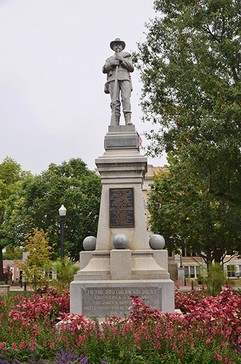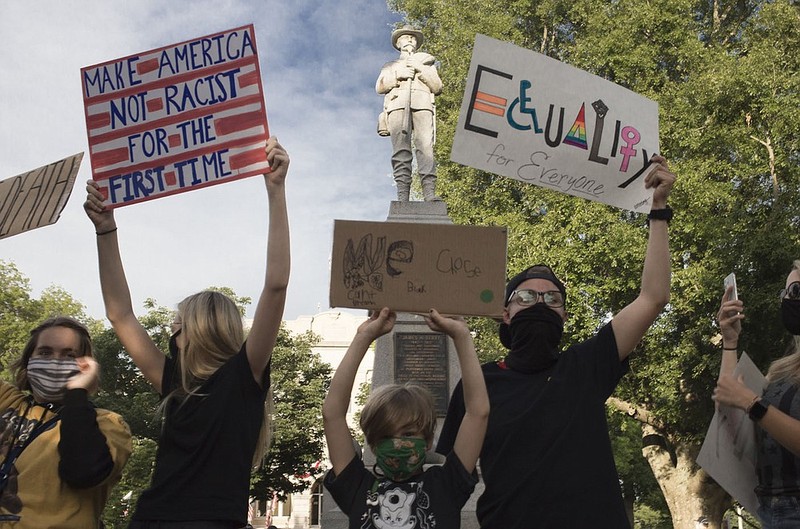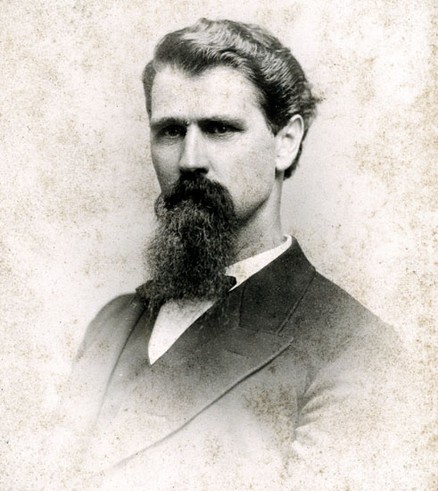Bentonville Confederate Monument
Introduction
Text-to-speech Audio
Images
Bentonville Confederate Monument

Protestors in front of Bentonville's Confederate Monument on June 1, 2020

James H. Berry

Backstory and Context
Text-to-speech Audio
Northwest Arkansas, including Bentonville and Benton County, carry a complicated Civil War legacy. Like many Upper South and Border States in 1861, Arkansas grappled with the possibility of secession. Initially remaining loyal to the United States in the crisis's early days, in the wake of Fort Sumter and President Lincoln's call for arms, Arkansas seceded in May. Five delegates voted against the secession ordinance; four of whom came from Northwest or North-Central Arkansas. Four were convinced to change their votes in favor; Isaac Murphy of Madison County (immediately east of Benton County) refused, becoming the lone dissenter.
As the secession vote suggests, there was consdierably dissent in Northwest Arkansas during the Civil War. A majority of the population supported the Confederacy, and approximately 1,000 men from Benton County enlisted in the Confederate army. Yet Northwest Arkansas was also home to a strong Unionist minority throughout the war. A number of Northwest Arkansans served in the United States army, notably in the First Arkansas Cavalry (U.S.). During the war, several battles occurred in Benton County, most prominently the 1862 Battle of Pea Ridge. Union and Confederate armies exchanged control of the region several times. The area suffered serious economic devastation, and Bentonville itself was burned during the war.
At the turn of the century, the local James H. Berry Chapter of the United Daughters of the Confederacy (UDC) sought to memorialize Benton County's Confederate past. This local initiative fit into a much larger movement across the South by the UDC, United Confederate Veterans (UCV), and other groups to vindicate the Confederacy. Between 1899 and 1915, 11 other Confederate monuments were raised by the Arkansas UDC alone. These monuments in Arkansas and the South often conveyed Lost Cause beliefs that minimized Confederate defeat and slavery's role in sparking the Civil War.
The monument was built at a cost of $2,500, raised by local banker A.J. Bates and prominent local citizen James H. Berry. James Berry served in the Confederate army, and postwar enjoyed a substantial political career, including a term as governor and as a U.S. Senator. A member of the UCV, Berry was proud of his Confederate service and supported efforts to memorialize the Confederacy. The monument depicts a Confederate soldier standing vigil atop a granite base, a common style among Civil War statues, and bears inscriptions on each of its four sides.
The dedication took place on August 8, 1908. Thousands were in attendance, including hundreds of Confederate veterans. Following a parade featuring floats through downtown Bentonville, various officials spoke in front of the Confederate flag draped monument. The keynote speech was given by Clifton R. Breckenridge (the son of former U.S. Vice President and Confederate General John C. Breckenridge). Echoing the Lost Cause sentiments of the era, Breckenridge proclaimed the South "had a perfect and constitutional right to secede" and determined the Confederacy fought to protect "the faithful administration of [the Constitution's] powers upon the sacred principal, not of privilege, but of equal rights."[1] Breckenridge's comments portray the Confederacy as fighting for abstract liberties, rather than slavery. In 1914, following James Berry's death, a bronze plaque was added to the monument in his honor. The statue was rededicated in 1996.
In recent years, the statue's legacy has come under contest. In the wake of the "Unite the Right" rally of white supremacists and neo-Confederates in August 2017 in Virginia, nearly 160 people gathered in protest of Bentonville's Confederate monument in September. The monument was also vandalized several times. On June 1, 2020, following the death of George Floyd and nationwide protests over systemic racism (many of which targeted Confederate monuments), the statue stood amidst a large "Justice for George Floyd" protest downtown which turned violent. The same day, the Arkansas Division of the UDC agreed to relocate the monument to James H. Berry Park (a private park where Berry is buried). The monument was removed on September 2, 2020.
Sources
1. Mark K. Christ. "Bentonville Confederate Monument." June 2, 2020. Encyclopedia of Arkansas. Web. Accessed July 21, 2020. https://encyclopediaofarkansas.net/entries/bentonville-confederate-monument-13207/
2. Adam Roberts. "The Bentonville Confederate Monument's history." August 19, 2017. ABC 40 29 News. Web. Accessed July 21, 2020. https://www.4029tv.com/article/the-bentonville-confederate-statues-history/12036596#
3. Mark K. Christ, ed. The Die is Cast: Arkansas Goes to War, 1861. Little Rock, AR: Butler Center Books, 2010.
4. Ralph Wooster. "The Arkansas Secession Convention." Arkansas Historical Quarterly. Vol. 13, No. 2. (Summer, 1954): 172-195.
5. "Benton County, Arkansas." Community and Conflict: The Impact of the Civil War in the Ozarks. Web. Accessed July 21, 2020. https://ozarkscivilwar.org/regions/benton-ak
6. George W. Balough. "James Henderson Berry." January 25, 2017. Encyclopedia of Arkansas. Web. Accessed July 21, 2020. https://encyclopediaofarkansas.net/entries/james-henderson-berry-88/
7. Mike Jones. "Statue relocation planned in Bentonville." June 14, 2020. Arkansas Democrat-Gazette. Web. Accessed July 22, 2020. https://www.arkansasonline.com/news/2020/jun/14/state-relocation-planned-in-bentonville/
8. Mike Jones and Tracy Neal. "Rally gets violent in Bentonville; tear gas deployed." June 2, 2020. Northwest Arkansas Democrat-Gazette. Web. Accessed July 22, 2020. https://www.nwaonline.com/news/2020/jun/02/rally-gets-violent-bentonville-tear-gas-deployed/
9. Max Brantley. "Bentonville Square loses its monument to slavery." September 2, 2020. Arkansas Times. Web. Accessed September 2, 2020. https://arktimes.com/arkansas-blog/2020/09/02/bentonville-square-loses-its-monument-to-slavery
Encyclopedia of Arkansas, https://encyclopediaofarkansas.net/media/bentonville-confederate-monument-12503/
Charilie Kaijo, Northwest Arkansas Democrat-Gazette, https://www.arkansasonline.com/news/2020/jun/14/state-relocation-planned-in-bentonville/
Encyclopedia of Arkansas, https://encyclopediaofarkansas.net/media/james-henderson-berry-gov-32/
